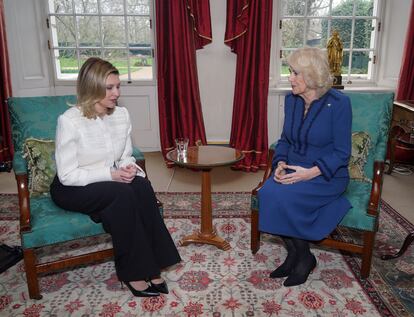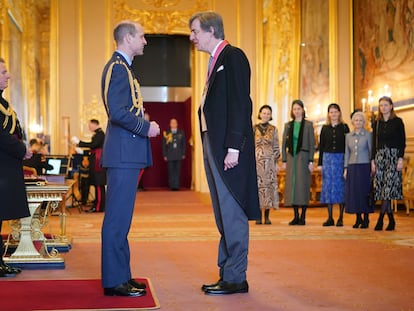Public absence of the British royal family sparks speculation in the United Kingdom
Buckingham Palace’s scant information on the health of Charles III and Kate Middleton, who was seen in a photograph Monday, raises more questions than answers

Everything about the British royal family since the beginning of the year has been steeped in the mystery of an Agatha Christie novel. And Then There Were None would be the perfect title for the successive disappearances from public life of the members of the Windsor household, which have unleashed a torrent of speculation and rumor, especially on social networks. First, the Princess of Wales, Catherine (Kate) Middleton, wife of the heir to the throne, Prince William, and almost immediately afterward King Charles III withdrew from the public eye due to health problems. Later, William also announced a pause in his public duties to attend to his wife, who was seen in apparently stolen photos on Tuesday. And even Queen Consort Camilla, who became almost exclusively in charge of representing the British royal household, has just announced that she is taking a week’s break overseas.
“It’s an ever-thickening fog of uncertainty. And it gives more energy to online rumors. It’s the problem of feeding out small pieces of information, enough to prompt more questions and not enough to give answers,” said Sean Coughlan, the BBC’s royal affairs correspondent, summing up the feeling of the British press.
In mid-January, Kensington Palace — the official residence and name given to the office handling the affairs of the Prince and Princess of Wales — announced that Kate Middleton, 42, had undergone “planned abdominal surgery.” With such a vague description, medical experts consulted by the British media began to speculate; it could be an intervention on the stomach, the appendix, the kidneys, or the reproductive system. “The Princess of Wales appreciates the interest this statement will generate. She hopes that the public will understand her desire to maintain as much normality for her children as possible; and her wish that her personal medical information remains private,” explained the official statement. The only thing that was made clear — and this was reported to the BBC — was that it was not cancer.
It was then announced that the Princess of Wales would remain hospitalized for 15 days and that she would not return to public activity until after Easter. Her husband William was applauded in the media for announcing that he too would take some time away from the spotlight to attend to his family.
The climate of mystery caused by the lack of information about the Princess of Wales — Kensington Palace even had to react to rumors that Middleton had suffered an induced coma, which they described as “absolute nonsense” — has been partly broken. The American gossip website TMZ published a photo, apparently obtained illicitly, of the princess, wearing dark glasses and with her mother in an Audi 4x4. They were driving around Windsor, around 9 a.m. on Monday, the time of day when schools open. The British media have not published the snapshot and have respected the royal couple’s request for privacy.
To add even more confusion, the website of the British Ministry of Defense announced the princesses’ attendance at a military parade scheduled for June 8. As honorary colonel of the Irish Guards, she will preside over the parade in preparation for the Trooping of the Colour, the official ceremony celebrating the King’s birthday, which will be on held on June 15. The Ministry’s website even offers tickets to attend the event, although Kensington Palace has declined to confirm the presence of the princess.
#KateMiddleton has surfaced for the first time since her hospitalization earlier this year that sidelined her for a good while.
— TMZ (@TMZ) March 5, 2024
See more 👉 https://t.co/OD6OfFQ09j pic.twitter.com/ZiBAXkp2Bq
King Charles III’s cancer
Almost at the same time as Middleton’s operation was made public, Buckingham Palace announced, as a matter of routine and without major significance, that Charles III was to be admitted to the same hospital as the Princess of Wales for treatment of a hypertrophic prostate. “In common with thousands of men each year, the King has sought treatment for an enlarged prostate. His Majesty’s condition is benign and he will attend hospital next week for a corrective procedure. The king’s public engagements will be postponed for a short period of recuperation,” the statement said.
But at the beginning of February the news broke that during the operation, doctors had detected in the monarch “a form of cancer” that had to be treated immediately. Since then, Charles has been out of the public eye while undergoing treatment. Buckingham Palace has declined to specify the type of cancer, or whether Charles was undergoing chemotherapy, radiotherapy, or immunotherapy. A video was released showing the king in a work meeting with Prime Minister Rishi Sunak, in which the head of state appeared smiling but with a weak voice. Another was subsequently published in which he is seen reading, for a few seconds, one of the more than 7,000 letters of support he has received since he was diagnosed.
Camilla’s workload
The temporary retirement of the monarch forced William to bring forward his return to public duty, to the point that comparisons were made with the final years of Elizabeth II, during which Charles increasingly occupied the space that corresponded to his mother. Buckingham Palace insisted that the king continued to conduct official business and that it was not necessary to activate the constitutional mechanism of the Counsellors of the State: by law, Camilla, William, or Princess Anne and Prince Edward (Charles’ siblings) can replace the monarch in case of serious illness, incapacity, or his absence overseas.
The alarms were triggered on February 27 when William announced, barely an hour before the ceremony, that he would not attend a Mass of honor that the British royal family had organized at St. George’s Chapel, in Windsor Castle, in memory of Constantine II of Greece, due to a “personal matter.” Constantine was the Prince of Wales’s godfather, and William was scheduled to read a text from the Old Testament during the ceremony. His unexplained absence again sparked rumors, and Kensington Palace had to come out again to disassociate his absence from his wife’s recovery. “Kensington Palace made it clear in January the timelines of the Princess’ recovery and we’d only be providing significant updates. That guidance stands,” a spokesman told ABC News.
The ceremony was eventually presided over by Queen Consort Camilla, who in the space of two months has become the most active member of the Windsor family. The work overload has taken its toll and the monarch has announced that she is going on vacation, at least until March 11, when she will preside the Commonwealth service at Westminster Abbey.
“I think Charles himself has told her to take a break. She has not stopped working and has represented her husband all this time. The idea of her taking a few days may be a sign that the king’s treatment is progressing favorably,” British royal biographer Angela Levin told GB News.
William is set to resume his public duties immediately to fill the vacuum but the past few weeks have been a time for the royal communications team to observe the consequences of its strategy of minimal information, and for the king to assess whether his plans for a reduced monarchy with a core of just four leading figures is workable when health issues complicate matters.
Sign up for our weekly newsletter to get more English-language news coverage from EL PAÍS USA Edition
Tu suscripción se está usando en otro dispositivo
¿Quieres añadir otro usuario a tu suscripción?
Si continúas leyendo en este dispositivo, no se podrá leer en el otro.
FlechaTu suscripción se está usando en otro dispositivo y solo puedes acceder a EL PAÍS desde un dispositivo a la vez.
Si quieres compartir tu cuenta, cambia tu suscripción a la modalidad Premium, así podrás añadir otro usuario. Cada uno accederá con su propia cuenta de email, lo que os permitirá personalizar vuestra experiencia en EL PAÍS.
¿Tienes una suscripción de empresa? Accede aquí para contratar más cuentas.
En el caso de no saber quién está usando tu cuenta, te recomendamos cambiar tu contraseña aquí.
Si decides continuar compartiendo tu cuenta, este mensaje se mostrará en tu dispositivo y en el de la otra persona que está usando tu cuenta de forma indefinida, afectando a tu experiencia de lectura. Puedes consultar aquí los términos y condiciones de la suscripción digital.
More information
Archived In
Últimas noticias
Most viewed
- Sinaloa Cartel war is taking its toll on Los Chapitos
- Reinhard Genzel, Nobel laureate in physics: ‘One-minute videos will never give you the truth’
- Oona Chaplin: ‘I told James Cameron that I was living in a treehouse and starting a permaculture project with a friend’
- Why the price of coffee has skyrocketed: from Brazilian plantations to specialty coffee houses
- David King, chemist: ‘There are scientists studying how to cool the planet; nobody should stop these experiments from happening’











































